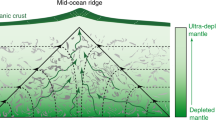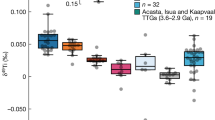Abstract
The timing of formation of the Earth’s continental crust is the subject of a long-standing debate1,2, with models ranging from early formation with little subsequent growth, to pulsed growth, to steadily increasing growth. But most models do agree that the continental crust was extracted from the mantle by partial melting3. If so, such crustal extraction should have left a chemical fingerprint in the isotopic composition of the mantle. The subduction of oceanic crust and subsequent convective mixing, however, seems to have largely erased this record in most mantle isotopic systems (for example, strontium, neodymium and lead). In contrast, helium is not recycled into the mantle because it is volatile and degasses from erupted oceanic basalts. Therefore helium isotopes may potentially preserve a clearer record of mantle depletion than recycled isotopes. Here I show that the spectrum of 4He/3He ratios in ocean island basalts appears to preserve the mantle’s depletion history, correlating closely with the ages of proposed continental growth pulses4,5. The correlation independently predicts both the dominant 4He/3He peak found in modern mid-ocean-ridge basalts, as well as estimates of the initial 4He/3He ratio of the Earth6. The correspondence between the ages of mantle depletion events and pulses of crustal production implies that the formation of the continental crust was indeed episodic and punctuated by large, potentially global, melting events. The proposed helium isotopic evolution model does not require a primitive, undegassed mantle reservoir, and therefore is consistent with whole mantle convection.
This is a preview of subscription content, access via your institution
Access options
Subscribe to this journal
Receive 51 print issues and online access
$199.00 per year
only $3.90 per issue
Buy this article
- Purchase on Springer Link
- Instant access to full article PDF
Prices may be subject to local taxes which are calculated during checkout


Similar content being viewed by others
References
Taylor, S. R. & McLennan, S. M. The geochemical evolution of the continental crust. Rev. Geophys. 33, 241–265 (1995)
Bowring, S. A. & Housh, T. The Earth’s early evolution. Science 269, 1535–1540 (1995)
Hofmann, A. W. Chemical differentiation of the Earth — the relationship between mantle, continental crust, and oceanic crust. Earth Planet. Sci. Lett. 90, 297–314 (1988)
Condie, K. C. Episodic continental growth and supercontinents: a mantle avalanche connection? Earth Planet. Sci. Lett. 163, 97–108 (1998)
Kemp, A. I. S., Hawkesworth, C. J., Paterson, B. A. & Kinny, P. D. Episodic growth of the Gondwana supercontinent from hafnium and oxygen isotopes in zircon. Nature 439, 580–583 (2006)
Mahaffy, P. R., Donahue, T. M., Atreya, S. K., Owen, T. C. & Niemann, H. B. Galileo probe measurements of D/H and 3He/4He in Jupiter’s atmosphere. Space Sci. Rev. 84, 251–263 (1998)
Allègre, C. J. & Moreira, M. Rare gas systematics and the origin of oceanic islands: the key role of entrainment at the 670 km boundary layer. Earth Planet. Sci. Lett. 228, 85–92 (2004)
Kurz, M. D., Jenkins, W. J. & Hart, S. R. Helium isotopic systematics of oceanic islands and mantle heterogeneity. Nature 297, 43–47 (1982)
Moreira, M., Breddam, K., Curtice, J. & Kurz, M. D. Solar neon in the Icelandic mantle: new evidence for an undegassed lower mantle. Earth Planet. Sci. Lett. 185, 15–23 (2001)
Porcelli, D. & Ballentine, C. J. Models for the distribution of terrestrial noble gases and evolution of the atmosphere. Rev. Mineral. Geochem. 47, 411–480 (2002)
Allègre, C. J., Hofmann, A. & O’Nions, K. The argon constraints on mantle structure. Geophys. Res. Lett. 23, 3555–3557 (1996)
Brooker, R. A. et al. The ‘zero charge’ partitioning behaviour of noble gases during mantle melting. Nature 423, 738–741 (2003)
Parman, S. W., Kurz, M. D., Hart, S. R. & Grove, T. L. Helium solubility in olivine and implications for high 3He/4He in ocean island basalts. Nature 437, 1140–1143 (2005)
Class, C. & Goldstein, S. L. Evolution of helium isotopes in the Earth’s mantle. Nature 436, 1107–1112 (2005)
Stuart, F. M., Lass-Evans, S., Fitton, J. G. & Ellam, R. M. High 3He/4He ratios in picritic basalts from Baffin Island and the role of a mixed reservoir in mantle plumes. Nature 424, 57–59 (2003)
Graham, D., Lupton, J., Albarède, F. & Condomines, M. Extreme temporal homogeneity of helium isotopes at Piton de la Fournaise, Réunion Island. Nature 347, 545–548 (1990)
Kurz, M. D. Mantle heterogeneity beneath oceanic islands — some inferences from isotopes. Phil. Trans. R. Soc. Lond. 342, 91–103 (1993)
Seta, A., Matsumoto, T. & Matsuda, J. Concurrent evolution of 3He/4He ratio in the Earth’s mantle reservoirs for the first 2 Ga. Earth Planet. Sci. Lett. 188, 211–219 (2001)
Stein, M. & Hofmann, A. W. Mantle plumes and episodic crustal growth. Nature 372, 63–68 (1994)
Armstrong, R. L. Radiogenic isotopes — The case for crustal recycling on a near-steady-state no-continental-growth Earth. Phil. Trans. R. Soc. Lond. 301, 443–472 (1981)
Burke, K. & Torsvik, T. H. Derivation of large igneous provinces of the past 200 million years from long-term heterogeneities in the deep mantle. Earth Planet. Sci. Lett. 227, 531–538 (2004)
Courtillot, V., Davaille, A., Besse, J. & Stock, J. Three distinct types of hotspots in the Earth’s mantle. Earth Planet. Sci. Lett. 205, 295–308 (2003)
Wen, L. X. A compositional anomaly at the Earth’s core-mantle boundary as an anchor to the relatively slowly moving surface hotspots and as source to the DUPAL anomaly. Earth Planet. Sci. Lett. 246, 138–148 (2006)
Allègre, C. J. & Turcotte, D. L. Implications of a two-component marble-cake mantle. Nature 323, 123–127 (1986)
Helffrich, G. R. & Wood, B. J. The Earth’s mantle. Nature 412, 501–507 (2001)
Hofmann, A. W. & White, W. M. Mantle plumes from ancient oceanic crust. Earth Planet. Sci. Lett. 57, 421–436 (1982)
Davies, G. F. Stirring geochemistry in mantle convection models with stiff plates and slabs. Geochim. Cosmochim. Acta 66, 3125–3142 (2002)
Zindler, A. & Hart, S. Chemical geodynamics. Annu. Rev. Earth Planet. Sci. 14, 493–571 (1986)
Butler, S. L., Peltier, W. R. & Costin, S. O. Numerical models of the Earth’s thermal history: Effects of inner-core solidification and core potassium. Phys. Earth Planet. Inter. 152, 22–42 (2005)
Davies, G. F. Punctuated tectonic evolution of the earth. Earth Planet. Sci. Lett. 136, 363–379 (1995)
Abedini, A. A., Hurwitz, S. & Evans, W. C. USGS-NoGaDat — A global dataset of noble gas concentrations and their isotopic ratios in volcanic systems. (US Geological Survey Digital Data Series, 202) 〈http://pubs.usgs.gov/ds/2006/202〉 (2006)
Acknowledgements
I thank G. Pearson, P. Martin and T. Grove for informal reviews, M. Kurz, S. Hart, M. Walter and J. Blundy for discussions, and A. Abedini for compiling the He isotope database. This research was supported by the Nuffield Foundation.
Author information
Authors and Affiliations
Corresponding author
Ethics declarations
Competing interests
Reprints and permissions information is available at npg.nature.com/reprintsandpermissions. The author declares no competing financial interests.
Supplementary information
Supplementary Information
The file contains a Supplementary Table 1 of the corresponding 4He/3He and zircon age peaks used in the regression in the text and in Figure 2. It also contains Supplementary Figure 1 which is a more comprehensive version of Figure 1, showing all of the ocean islands for which there are more than 10 analyses, separating out various ridge systems and also showing the underlying histograms for the probability distribution functions. (PDF 301 kb)
Rights and permissions
About this article
Cite this article
Parman, S. Helium isotopic evidence for episodic mantle melting and crustal growth. Nature 446, 900–903 (2007). https://doi.org/10.1038/nature05691
Received:
Accepted:
Issue Date:
DOI: https://doi.org/10.1038/nature05691
This article is cited by
-
Earth’s evolving geodynamic regime recorded by titanium isotopes
Nature (2023)
-
Quantitative simulation and prediction of extreme geological events
Science China Earth Sciences (2022)
-
Formation of Venus, Earth and Mars: Constrained by Isotopes
Space Science Reviews (2021)
-
Do Supercontinent-Superplume Cycles Control the Growth and Evolution of Continental Crust?
Journal of Earth Science (2020)
-
Selective ingress of a Samoan plume component into the northern Lau backarc basin
Nature Communications (2015)
Comments
By submitting a comment you agree to abide by our Terms and Community Guidelines. If you find something abusive or that does not comply with our terms or guidelines please flag it as inappropriate.



